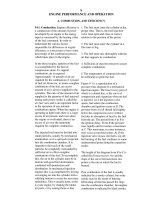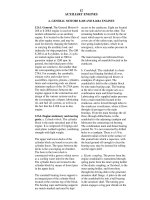Tài liệu Cutting Tools P14 docx
Bạn đang xem bản rút gọn của tài liệu. Xem và tải ngay bản đầy đủ của tài liệu tại đây (227.31 KB, 8 trang )
www.toolingandproduction.com
Chapter 14/Tooling & Production
1
Metal Removal
Cutting-Tool Materials
Metal Removal Methods
Machinability of Metals
Single Point Machining
Turning Tools and Operations
Turning Methods and Machines
Grooving and Threading
Shaping and Planing
Hole Making Processes
Drills and Drilling Operations
Drilling Methods and Machines
Boring Operations and Machines
Reaming and Tapping
Multi Point Machining
Milling Cutters and Operations
Milling Methods and Machines
Broaches and Broaching
Saws and Sawing
Abrasive Processes
Grinding Wheels and Operations
Grinding Methods and Machines
Lapping and Honing
George Schneider, Jr. CMfgE
Professor Emeritus
Engineering Technology
Lawrence Technological University
Former Chairman
Detroit Chapter ONE
Society of Manufacturing Engineers
Former President
International Excutive Board
Society of Carbide & Tool Engineers
Lawrence Tech.- www.ltu.edu
Prentice Hall- www.prenhall.com
Broaches
and Broaching
14.1 Introduction
The broaching operation is similar to
shaping with multiple teeth and is used
to machine internal and external sur-
faces such as holes of circular, square,
or irregular shapes, keyways, and teeth
of internal gears. A broach is a long
multitooth cutting tool with succes-
sively deeper cuts. Each tooth removes
a predetermined amount of material in
a predetermined location. The total
depth of material removed in one path
is the sum of the depth of cut of each
tooth. Broaching is an important pro-
duction process and can produce parts
with very good surface finish and di-
mensional accuracy. Broaching com-
petes favorably with other processes
such as boring, milling, shaping and
reaming. Although broaches tend to be
expensive, the cost is justified because
of their use for high production runs.
A two station broaching operation is
shown in Figure 14.1.
14.2 Broaching
Tooling is the heart of any broaching
process. The broaching tool is based
on a concept unique to the process -
CHAPTER 14
FIGURE 14.1: Typical broaching operation of an internal spline. (Courtesy Detroit
Broach & Machine Co.)
Chap. 14: Broaches & Broaching
2
Tooling & Production/Chapter 14
www.toolingandproduction.com
rough, semi-finish, and finish cutting
teeth combined in one tool or string of
tools. A broach tool frequently can
finish machine a rough surface in a
single stroke. A large broach is shown
in Figure 14.2
For exterior surface broaching, the
broach tool may be pulled or pushed
across a workpiece surface, or the sur-
face may move across the tool. Inter-
nal broaching requires a starting hole
or opening in the workpiece so the
broaching tool can be inserted. The
tool or the workpiece is then pushed or
pulled to force the tool through the
starter hole. Almost any irregular
cross-section can be broached as long
as all surfaces of the section remain
parallel to the direction of broach
travel. A couple of small broached
parts are shown in Figure 14.3
14.2.1 Broaching Tools
A broach is like a single point tool with
many ‘points’ each of which cuts like a
flat-ended shaper tool, although some
broaches have teeth set diagonally,
called sheer cutting. The principal
parts of an internal broach are shown
in Figure 14.4
14.3 Broach Nomenclature
Front Pilot: When an internal pull
broach is used, the pull end and front
pilot are passed through the starting
hole. Then the pull end is locked to the
pull head of the broaching machine.
The front pilot assures correct axial
alignment of the tool with the starting
hole, and serves as a check on the
starting hole size.
Length: The length of a broach tool
or string of tools, is determined by the
amount of stock to be removed, and
limited by the machine stroke.
Rear Pilot: The rear pilot main-
tains tool alignment as the final finish
teeth pass through the workpiece hole.
On round tools the diameter of the rear
pilot is slightly less than the diameter
of the finish teeth.
Broach tooth nomenclature and ter-
minology are shown in Figure 14.5a.
Cutting Teeth: Broach teeth are
usually divided into three separate sec-
tions along the length of the tool: the
roughing teeth, semi-finishing teeth,
and finishing teeth (Fig. 14.4). The
first roughing tooth is proportionately
the smallest tooth on the tool. The
subsequent teeth progressively increase
in size up to and including the first
FIGURE 14.2: A large broach is shown (Courtesy Detroit Broach &
Machine Co.)
FIGURE 14.3: A couple of small broached parts are shown. (Courtesy
Detroit Broach & Machine Co.)
Roughing
teeth
Shank length
Length to
first tooth
Cutting teeth
Front pilot
Semifinishing
teeth
Finishing
teeth
Rear pilot
Follow rest
Pull end
FIGURE 14.4: Principal parts of a round internal-pull broach.
Chap. 14: Broaches & Broaching
www.toolingandproduction.com
Chapter 14/Tooling & Production
3
finishing tooth. The difference in
height between each tooth, or the tooth
rise, is usually greater along the rough-
ing section and less along the semi-
finishing section. All finishing teeth
are the same size. The face is ground
with a hook or face angle that is deter-
mined by the workpiece material. For
instance, soft steel workpieces usually
require greater hook angles; hard or
brittle steel pieces require smaller hook
angles.
Tooth Land: The land supports the
cutting edge against stresses. A slight
clearance or backoff angle is ground
onto the lands to reduce friction. On
roughing and semi-finishing teeth, the
entire land is relieved with a backoff
angle. On finishing teeth, part of the
land immediately behind the cutting
edge is often left straight, so that re-
peated sharpening (by grinding the
face of the tooth) will not alter the
tooth size.
Tooth Pitch: The distance between
teeth, or pitch, is determined by the
length of cut and influenced by type of
workpiece material. A relatively large
pitch may be required for roughing
teeth to accommodate a greater chip
load. Tooth pitch may be smaller on
semi-finishing teeth to reduce the over-
all length of the broach tool. Pitch is
calculated so that preferably, two or
more teeth cut simultaneously. This
prevents the tool from drifting or chat-
tering.
Tooth Gullet: The depth of the
tooth gullet is related to the tooth rise,
pitch, and workpiece material. The
tooth root radius is usually designed so
that chips curl tightly within them-
selves, occupying as little space as
possible. (Fig. 14.5b)
When designing broaches, attention
must also be given to chip load,
chipbreakers, shear angles and side
relief.
Chip Load: As each tooth enters
the workpiece, it cuts a fixed thickness
of material. The fixed chip length and
thickness produced by broaching create
a chip load that is determined by the
design of the broach tool and the pre-
determined feed rate.
This chip load feed rate cannot be
altered by the machine operator as it
can in most other machining opera-
tions. The entire chip produced by a
complete pass of each broach tooth
must be freely contained within the
preceding tooth gullet (Fig. 14.5b).
The size of the tooth gullet is a func-
tion of the chip load and the type of
chips produced. However the form that
each chip takes depends on the
workpiece material and hook. Brittle
materials produce flakes. Ductile or
malleable materials produce spiral
chips.
Chipbreakers: Notches, called
chipbreakers, are used on broach tools
to eliminate chip packing and to facili-
tate chip removal. The chipbreakers
are ground into the roughing and semi-
finishing teeth of the broach, parallel
to the tool axis. Chipbreakers on alter-
nate teeth are staggered so that one set
of chipbreakers is followed by a cutting
edge. The finishing teeth complete the
job. Chipbreakers are vital on round
broaching tools. Without the
chipbreakers, the tools would machine
ring-shaped chips that would wedge
into the tooth gullets and eventually
cause the tool to break.
Shear Angle: Broach designers
may place broach teeth at a shear angle
to improve surface finish and reduce
tool chatter. When two adjacent sur-
faces are cut simultaneously, the shear
angle is an important factor in moving
chips away from the intersecting cor-
ner to prevent crowding of chips in the
intersection of the cutting teeth.
Another method of placing teeth at a
shear angle on broaches is by using a
herringbone pattern. An advantage of
this design is that it eliminates the
tendency for parts to move sideways in
the workholding fixtures during
broaching.
Side Relief: When broaching slots,
the tool becomes enclosed by the slot
during cutting and must carry the chips
produced through the entire length of
the workpiece. Sides of the broach
teeth will rub the sides of the slot and
cause rapid tool wear unless clearance
is provided. Grinding a single relief
angle on both sides of each tooth does
this. Thus only a small portion of the
tooth near the cutting edge, called the
side land, is allowed to rub against the
slot. The same approach is used for
one sided corner cuts and spline
broaches.
14.4 Types of Broaches
Two major types of broaches are the
push broach and the pull broach. A
second division is internal and external
broaches.
Push and Pull Broaches: A push
broach must be relatively short since it
is a column in compression and will
buckle and break under too heavy a
load. Push broaches are often used
with a simple arbor press if quantities
of work are low. For medium to high
Cut per tooth
(feed/tooth)
Tooth depth
Face or hook angle
Pitch
Land, or tooth width
Backoff or
rake angle
(a)
Radius Gullet or
chip space
(b)
FIGURE 14.5: (a)
Broach tooth
nomenclature and
terminology. (b)
Illustration of
how a chip fills
the gullet during
a broaching
operation.
Chap. 14: Broaches & Broaching
4
Tooling & Production/Chapter 14
www.toolingandproduction.com
volume production they are used in
broaching machines.
Pull broaches (Fig. 14.4) are pulled
either up, down, or horizontally
through or across the workpiece, al-
ways by a machine. Flat or nearly flat
broaches may be pull type, or the
broach may be rigidly mounted, with
the workpiece then pulled across the
broaching teeth. Automobile cylinder
blocks and heads are often faced flat by
this method. Figure 14.6 shows vari-
ous broach configurations both round
and flat types.
Figure 14.1 shows a vertical spline
broaching operation; Figure 14.7
shows a large spline broaching opera-
tion using a horizontal broaching ma-
chine.
14.4.1 Internal Broaches
Internal broaches are either pulled or
pushed through a starter hole. The
machines can range from fully auto-
mated multi stationed verticals, to
horizontal pull types, to simple
presses. Figure 14.8 shows a variety of
forms that can be produced by internal
broaches.
Keyway Broach: Almost all key-
ways in machine tools and parts are cut
by a keyway broach - a narrow, flat bar
with cutting teeth spaced along one
surface. Both external and internal
keyways can be cut with these
broaches. Internal keyways usually
require a slotted bushing or horn to fit
the hole, with the keyway broach
pulled through the horn, guided by the
slot.
If a number of parts, all of the same
diameter and keyway size, are to be
machined, an internal keyway broach
can be designed to fit into the hole to
support the cutting teeth. Only the
cutting teeth extend beyond the hole
diameter to cut the keyway. Bushings
or horns are not required.
Burnishers: Burnishers are broach-
ing tools designed to polish rather than
cut a hole. The total change in diam-
eter produced by a burnishing opera-
tion may be no more than 0.0005 to
0.001 inch. Burnishing tools, used
when surface finish and accuracy are
critical, are relatively short and are
generally designed as push broaches.
Burnishing buttons sometimes are
included behind the finishing tooth
section of a conventional broaching
tool. The burnishing section may be
added as a special attachment or easily
replaced shell. These replacement
shells are commonly used to reduce
tooling costs when high wear or tool
breakage is expected. They are also
used to improve surface finish.
Shell Broaches: Shell broaches can be
used on the roughing, semi-finishing and
finishing sections of a broach tool. The
principal advantage of a shell broach is
that worn sections can be removed and
re-sharpened or replaced, at far less cost
than a conventional single piece tool.
When shells are used for the finishing
teeth of long broaches, the teeth of the
FIGURE 14.6:
Various broach
configurations,
both round and
flat types.
FIGURE 14.7: A large spline broaching operation using a horizontal broaching
machine. (Courtesy US Broach & Machine Co.)
Keyway
Spline
Square
Triangle
Hexagon Double D
Special shapes
FIGURE 14.8: A
variety of forms that
can be produced
with an internal
broach.
Chap. 14: Broaches & Broaching
www.toolingandproduction.com
Chapter 14/Tooling & Production
5
shell can be ground to far greater accu-
racy than those of a long conventional
broach tool and the tool can continue to
be used by replacing the shell. Shell
broaches are similar to shell milling
cutters that were discussed in Chapter
12.
14.4.2 Surface Broaches
The broaches used to remove material
from an external surface are commonly
known as surface broaches. Such
broaches are passed over the workpiece
surface to be cut, or the workpiece
passes over the tool on horizontal, ver-
tical, or chain machines to produce flat
or contoured surfaces.
While some surface broaches are of
solid construction, most are of built-up
design, with sections, inserts, or
indexable tool bits that are assembled
end-to-end in a broach holder or sub
holder. The holder fits on the machine
slide and provides rigid alignment and
support. A surface broach assembly is
shown in Figure 14.9a.
Sectional Broaches: Sectional
broaches are used to broach unusual or
difficult shapes, often in a single pass.
The sectional broach may be round or
flat, internal or external. The principle
behind this tool is similar to that of the
shell broach, but straight sections of
teeth are bolted along the long axis of
the broach rather than being mounted
on an arbor. A complex broaching tool
can be built up from a group of fairly
simple tooth sections to produce a cut
of considerable complexity.
Carbide Broach Inserts: Broach-
ing tools with brazed carbide broach
inserts are frequently used to machine
cast iron parts. Present practice, such
as machining automotive engine
blocks, has moved heavily to the use of
indexable inserts (Fig. 14.9b) and this
has drastically cut tooling costs in
many applications.
Slab Broaches: Slab broaches,
simple tools for producing flat sur-
faces, come closest to being truly gen-
eral purpose broaches. A single slab
broach can be used to produce flat
surfaces having different widths and
depths on any workpiece by making
minor adjustments to the broach, fix-
ture and/or machine.
Slot Broaches: Slot broaches are
for cutting slots, but are not as general
purpose in function as slab broaches.
Adjustments can easily be made to
produce different slot depths, but slot
widths are a function of the broach
width. When sufficient production
volume is required however, slot
broaches are often faster and more
economical than milling cutters. In
broaching, two or more slots can often
be cut simultaneously.
14.5 Types of Broaching Machines
The type of broach cutting tool re-
quired for a given job is the single most
important factor in determining the
type of broaching machine to be used.
Second in importance is the production
requirement. Taken together, these
factors usually determine the specific
type of machine for the job.
The type of broach tool (internal or
surface) immediately narrows down
the kinds of machines that could be
used. The number of pieces required
per hour, or over the entire production
run, will further narrow the field.
For internal broaching, the length of
a broach in relation to its diameter may
determine whether it must be pulled
rather than pushed through the
workpiece, for a broach tool is stronger
in tension than in compression. This
in turn, helps determine the type of
machine for the job.
The type of drive, hydraulic or elec-
tromechanical, is another important
factor in machine selection. So are
convertibility and automation. Some
machine designs allow for conversion
from internal to surface work. Some
designs are fully automated; others are
limited in scope and operate only with
close operator supervision.
14.5.1 Vertical Broaching
Machines
About 60 percent of the total numbers
of broaching machines in existence are
vertical, almost equally divided be-
tween vertical internals and vertical
surface or combination machines. Ver-
tical broaching machines, used in ev-
ery major area of metalworking, are
almost all hydraulically driven. Figure
14.1 shows a vertical broaching opera-
tion.
One of the essential features that
promoted their development however,
is beginning to turn into a limitation.
Cutting strokes now in use often ex-
ceed existing factory ceiling clear-
ances. When machines reach heights
of 20 feet or more, expensive pits must
be dug for the machine, so that the
operator can work at the factory floor
level. A large vertical broaching ma-
chine is shown in Figure 14.10a.
Vertical internal broaching ma-
chines are table-up, pull-up, pull-
down, or push-down, depending on
their mode of operation.
Vertical Table-up: Today table-up
machines are demanded to meet the
cell concept (flexible) manufacturing,
where short runs of specialized compo-
(a)
(b)
FIGURE 14.9: (a) A surface broach assembly. (Courtesy Detroit Broach & Machine
Co.) (b) A surface broach assembly with indexable carbide inserts. (Courtesy
Ingersoll Cutting Tools)









